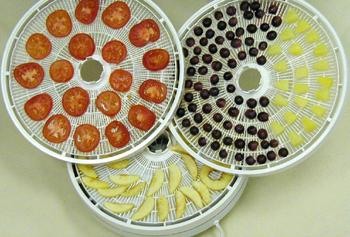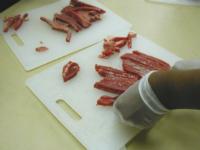Dehydration

Commonly dried foods include jerky, vegetables, and fruits. Fruits are sometimes pureed and made into leathers, and both vegetables and fruits can be powdered after drying to be used as flavorings during cooking. Dried, powdered ingredients can also be used to make rubs and seasoning mixes that make great gifts.
There is excellent information available on drying at the National Center for Home Food Preservation as well as in the owner's manuals included in most electric dehydrators. They are an excellent place to start. Some topics of local interest are included here as well.
Jerky
Jerky is a lightweight, dried meat product that is a handy food for backpackers, campers and outdoor sports enthusiasts. It requires no refrigeration if it is prepared properly, although many people do store theirs in the refigerator.
Raw meats can be contaminated with microorganisms that cause disease. These harmful bacteria can easily multiply on moist, high protein foods like meat and poultry and can cause illness if the products are not handled correctly.
Wild Meat
If pork or wild game is used to make jerky, the meat should be treated to kill the trichinella parasite before it is sliced and marinated. This parasite causes the disease trichinosis. To treat the meat, freeze a portion that is 6 inches or less thick at 0ºF or below for at least 30 days. Freezing will not eliminate bacteria from the meat.
When preparing jerky from wild game, it is important to remember that the wound location and skill of the hunter can affect the safety of the meat. If the animal is wounded in such a way that the contents of its gut come in contact with the meat or the hunter’s hands while dressing the meat, fecal bacteria can contaminate the meat. It is best to avoid making jerky from this meat and use it only in ways that it will be thoroughly cooked. Deer carcasses should be rapidly chilled to avoid bacterial growth. Here is a fact sheet on processing big game.
Safe Practices in Making Jerky

- Always wash hands thoroughly with soap and running water for at least 20 seconds before and after handling raw meats.
- Use clean equipment and utensils.
- Keep meat and poultry refrigerated at 40ºF or below. Use ground beef and poultry within 2 days, red meats within 3 to 5 days or freeze for later use.
- Thaw frozen meat in the refrigerator, not on the kitchen counter.
- Marinate meat in the refrigerator. Do not save and re-use marinade.
The risk of foodborne illness from home-dried jerky can be decreased by allowing the internal temperature of the meat to reach 160ºF, but in such a way as to prevent case hardening. Two methods can be used: heating meat strips in marinade before drying or heating the dried jerky strips in an oven after the drying process is completed. Directions for both methods are below. When the strips are heated in a marinade before drying, drying times will be reduced. Color and texture will differ from traditional jerky.
Jerky Marinade
There are many options for creating a marinade for jerky, but this one is recommended and tested from NCHFP.
- 1 1/2 - 2 pounds of lean meat (beef, pork or venison)
- 1/4 cup soy sauce
- 1 tablespoon Worcestershire sauce
- 1/4 teaspoon each of black pepper and garlic powder
- 1/2 teaspoon onion powder
- 1 teaspoon hickory smoke-flavored salt
Combine all ingredients. Place strips of meat in a shallow pan and cover with marinade. Cover and refrigerate 1-2 hours or overnight. Products marinated for several hours may be more salty than some people prefer. If you choose to heat the meat prior to drying to decrease the risk of foodborne illness, do so at the end of the marination time. To heat, bring strips and marinade to a boil and boil for 5 minutes before draining and drying. If strips are more than ¼ inch thick, the length of time may need to be increased. If possible, check the temperature of several strips with a metal stem-type thermometer to determine that 160ºF has been reached.
Recommended Sources of Information
We recommend using the following processes to make jerky safely:
National Center for Home Food Preservation
Colorado State University Extension has information on a Hot Pickling Brine and Vinegar Marinade as alternative processes to make jerky, especially from wild meat. LINK. (Also contains information on making leathers.)
Sierra Herb Salt
We have taught this easy seasoned salt recipe at several workshops. It is always a hit!
It requires no special equipment and can be air dried indoors; however, a dehydrator with drying sheets or parchment paper may also be used. These herbs all grow well in our area.
Yield: ¾ cup
Ingredients
- 4-5 garlic cloves, peeled
- Scant ½ c Kosher salt
- About 2 cups loosely-packed pungent fresh herb mix of fresh rosemary, sage, basil, and thyme leaves
Hand-Chopped Method
Cut each garlic clove lengthwise through the center, remove the sprout (if any) in the center and discard. Mound the salt and garlic on a cutting board. Use a chef’s knife to mince the garlic, blending it with the salt as you work.
Place herbs in a mound and coarsely chop them. Add the herbs to the garlic salt and chop them together to the texture of coarse sand.
Spread the salt on a baking sheet or in wide flat bowls and leave near an open window for a couple of days to dry, or use a dehydrator on a low heat setting appropriate for the herbs for 4 to 8 hours, checking periodically for dryness. Store in clean, dry jars.
